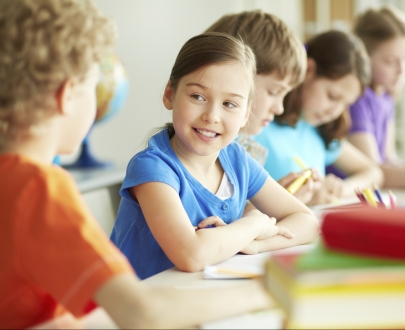
Breaking down walls of fear and judgment, and building understanding, empathy and friendship between students in a classroom is essential for Behaviour Consultant and Parenting Coach Janis Joseph, particularly when one of those students has a developmental challenge. Janice is invited into a school when a family or a staff member has identified a child who “doesn’t fit in” for any number of reasons and uses techniques that support relationship building[1] between children. The following activity is based on her work in elementary and middle school classrooms.
A Getting to Know You Session is intended to provide clarity about both the differences and the similarities between the “focus child” and the other students. Using a powerpoint presentation and class dialogue, photos of the child help to correct assumptions, provide accurate information and begin to remove hesitations about getting to know their classmate. To be successful, it requires an adult facilitator who is able to model non-judgmental, curious and accepting behaviours and who has a relationship with the parents or caregivers of the focus child.
Step One
Ask the family to take a series of photos of the focus child.
a) Engaged in their favourite game/sport/hobby.
b) In a variety of recognizable locations around town.
c) With people who they know and care about.
Step Two
Compile the photos into a powerpoint slide show. If possible include music chosen by the focus child.
Step Three
Before showing the powerpoint show to the class, ask the focus child whether they would like to be present during the Getting to Know You session. There are pro’s and con’s either way, so giving a choice is a way to honour their comfort level. When the child is present for this session, a shared experience is created that sets the stage for honesty and respect in future interactions. Students will appreciate the bravery of the focus child who will then be witness to a growing understanding and empathy from his or her peers. Alternatively, when the child chooses not to be present, the class may feel more open to ask questions and reveal their own fears and vulnerabilities.
Step Four
Show the powerpoint and engage the class in three primary dialogues:
-
From the slideshow, what do you have in common with [the child’s name]? (Students will have visually connected with familiar places, activities and people from the slide show.)
-
What do you already know about [the developmental challenge]? What questions do you have?
-
Brainstorm what you (individually and as a group) can do to help [the child] in school and on the playground.
Adaptations:
- For older students, have the class research about [the developmental challenge] and present at a school-wide assembly to raise awareness about differences in abilities and celebrate commonalities in shared positive human qualities.
-
Dr. Timmons and a team of researchers at the University of Prince Edward Island (PEI), identified current teaching and parenting practices[2] in PEI that address educational challenges and learning needs of children with autism. One approach includes creating student brochures, similar to a print version of the Getting to Know You session. As an extension, this lesson plan engages all the students in the classroom to create a personal brochure to deepen the awareness about both similarities and differences among all students.
Address three common barriers that have been identified from a National (US) survey focus on:
1. Opportunity Barrier - strategy: expand shared activities between students
2. Attitudinal Barrier - strategy: equip peers with the information and skills to build friendships
3. The "Adult" Barrier - strategy: adults to take a facilitative approach with students as compared to direct support.
This report shares both a review of promising practices for supporting students with Autism Spectrum Disorders as well as a series of lesson plans that support inclusive practices in schools.